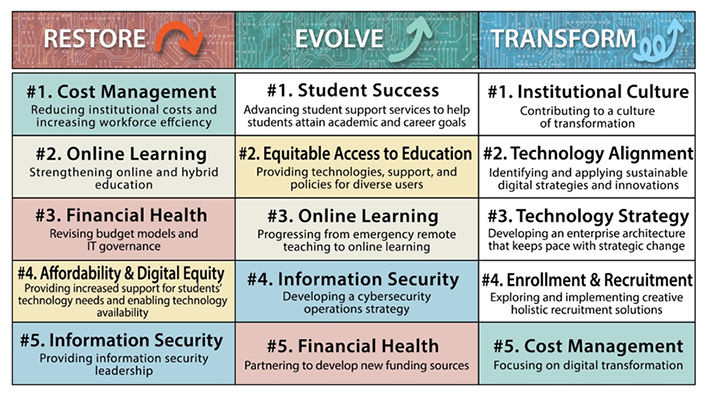When universities implemented modern networks to face the pandemic, transformational opportunity was born
An unexpected challenge fuels a connected campus evolution

EDUCAUSE's annual Top IT Issues list routinely guides higher education IT strategy for the coming year. However, due to the challenges schools faced due to COVID-19, the organization shifted the focus of its annual list. Rather, it created three scenarios to show how institutions might emerge from the pandemic.
Check out the chart below to see the top challenges within each scenario, but for me, one scenario stuck out: “Transform. We will be focused on redefining our institution and taking an active role in creating the innovative future of higher education.”

Source: EDUCAUSE
The “transform” scenario holds the most promise for institutions of higher education as we look to a possible post-pandemic world. The opportunity to redefine an institution while at the same time driving innovation in the space should appeal to most leaders as technology affects everything from student enrollment to instruction to retention.
And, for me, perhaps the most transformational opportunity in higher education is the evolution of the connected, or smart, campus.
Creating a connected campus
The connected campus vision has evolved over the last few years. Initially, higher education focused on instructional technology — the “smart classroom” part of smart campuses — and the emergence of Internet of Things (IoT) devices that simplified facilities management and campus safety.
Now, the emphasis is shifting, building on the implementation of smart classroom and IoT applications to drive to convergence: connecting those disparate systems in ways that leverage data to help institutions make better business decisions and improve student outcomes and engagement.
An underlying impediment to converging campus technology is the legacy network tasked with pulling together all the disparate pieces. Smart campus technology frequently is added to existing networks that aren’t optimized to support it. They may not offer enough bandwidth, enough flexibility or enough reliability.
A reliable, fast, scalable network — a modern one — can help. Here are top attributes of a modern network that can support a connect campus.
- Capacity: It’s not only student and faculty headcount but also their number and types of devices (smartphones, laptops, tablets, etc.) that will access the network. Also, count the number of IoT devices. And remember, these numbers will likely continue to grow.
- Resiliency: Plan for network outages and identify alternatives to ensure that teaching and learning and other critical operations aren’t disrupted when problems arise.
- Flexibility: Infrastructure should be scalable and flexible, capable of adjustments such as adding new locations or adjusting bandwidth.
- Visibility: Analytics can provide real-time insights into network performance, allowing staff to make changes when needed.
- Efficiency: Traffic steering and other tools can help prioritize mission-critical applications, which helps campus environments where bandwidth-heavy streaming video often competes with security and operational applications.
- WiFi: Along with providing more access in outdoor locations, modern wireless solutions can automatically optimize network performance in crowded areas such as academic buildings or stadiums and create separate networks for student, research and administrative use.
Realizing the promise of transformational change that comes with a connected campus requires higher education leaders to approach technology in new ways, building modern networks that enable innovation. To learn more about this shift, check out this white paper.
Keep up on the latest
Sign up now to get additional stories on connectivity, security and more.
Forms cannot be submitted at this time. Please call to speak with a representative.